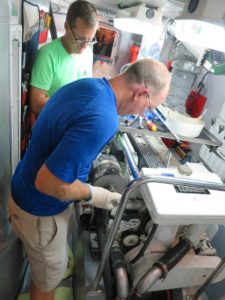
To be honest, on our last boat (a 40 foot Manta sailing catamaran called Double Wide) I never did a shakedown sail before any of our extended cruises. We just fixed what we knew was broken (if we thought it was important), loaded the boat with groceries, and set out for new adventures. But ROAM, our Nordhavn 47, is a different class of vessel with 10X the level of complexity of Double Wide. More complex systems mean more opportunities for breakdown. With this in mind, the the past few months have been dedicated to fixing broken systems and doing preventative maintenance on others. The last thing to do before we could declare Roam ready to go is run her hard to make sure everything works and to verify that nothing more has broken while we’ve been at the dock (cause boats do that you know — they just break while they’re sitting!).
With our friends Mark & Michele aboard, we set off on a 33 hour speed run to Marathon, FL in the Keys, expecting (hoping) that nothing would go wrong on our trip south.
I was alone at the helm a little before 9:00 PM when I caught the first whiff of smoke…

I consider myself to be a competent boater. I’ve logged thousands of miles and encountered and overcome dozens of problems that many would have been overwhelmed by, but I was able to calmly repair on the fly. The only thing that terrifies me when at sea is FIRE. When fire breaks out on a boat there is usually no good outcome. There is little time to react and almost no chance of saving a burning boat. So when I got the first whiff of smoke in the pilot house, I was up and moving to the engine room at dead run!
I peaked through the window on the engine room door before opening it. I could see smoke, but no open flames, so in I dove in for a quick inspection. Within a few seconds, Mark and had I found the culprit to be the big 270 amp alternator. The bearings had seized and it was smoking and sparking like the fourth of July! After switching to the “Get Home” engine and shutting down the main, Mark measured the temperature on the alternator at over 600 degrees!
We carry many spares parts aboard Roam, including a replacement alternator, so Mark and I had the old alternator changed out within 90 minutes and we were back under way. I think we’d have been able to get it done in less than 45, but we had to wait for the hunk of metal to cool down so that we could handle it.

The rest of the trip was pretty routine as far as shakedown cruises go. We had a couple of layover days in Marathon and we filled that time with snorkeling at Sombrero Reef, picnics at the beach, and relaxing sunsets (with cocktails, of course). Cruising at its finest!
As I write this we have completed our run to and from Marathon and we’re now at the dock at Old Port Cove Marina in Palm Beach, happy to have made the trip and and pleased that we pushed Roam a bit in order to uncover weaknesses that could affect our trip to Bermuda.
T-Minus 5 days….





Keep posting and I won’t have to “drop in”! Hugs to you both !
That’s a big alternator. Too much force and heat for your needs, Should have slackened the alternator adjustment and keep going on the main engine. you’ve have plenty of back up for your DC voltage needs. Great blog!
Just a novice-Plz explain? Are you saying one doesn’t need the alternator to run? My Volvo car alternator just died the other day and the whole car went dead while driving. And what do you mean; to much force and heat, and “slackended the Alt adjustment? did you mean lessen the tension on the Alt belt? Thanks 1-2yrs away from having our own Nordy and I’m on a crash course of learning!!!
David, your car engine is a different beast entirely and I can’t speak to what a Volvo engine needs to run. On Roam, we’re running a Lugger LP668T engine that has two alternators. The large alternator discussed in this blog post runs on a serpentine belt that also runs other critical components. While we could run without the alternator, we’d have to fashion a shorter belt that did not include the alternator. I actually have an emergency belt that would accomplish this, but since we had the spare alternator, it made more sense to replace it.
David, we could probably use a smaller alternator if the only goal was to maintain the real-time current needs, but there would then be nothing left to charge batteries. At rest, without any of the 240VAC devices, the boat typically uses between 45 and 75 Amps. Under power, the boat uses about 100-135 Amps., so you can see that that doesn’t leave much for charging batteries while underway.